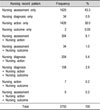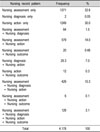Abstract
Objective
The objective of this study is to compare nursing records before and after the implementation of an electronic nursing records system.
Methods
Twenty patients' paper-based nursing records and 20 patients' electronic nursing records were analyzed according to the nursing process and compared in terms of quantity and quality.
Results
In terms of quantity, the average number of statements documented per patient per day has increased by 2.5 times, from 10.3 to 25.6 statements. The average number of redundancies of a unique statement also has increased by 67%, from 5.0 to 8.8. As for the content of nursing records, paper-based nursing records have more patient problem statements describing signs and symptoms, nursing observations, and patient status. Electronic nursing records have more nursing activity statements. In terms of quality, there were more nursing records following patterns of nursing process in electronic nursing records than paper-based nursing records. The electronic nursing records have a more detailed documentation compared to the paper-based nursing records.
Figures and Tables
References
1. Jennings BM, Loan LA. Misconceptions among nurses about evidence-based practice. Journal of Nursing Scholarship. 2001. 33(2):121–127.

2. Kim HS. Development and application of the computerized nursing process program for orthopedic surgery inpatients. Korean society of nursing science. 2005. 35(6):979–990.

3. Park HA, Cho IS, Hwang JI, Kwon HG. Nursing Outcome Classification Nursing Classification System Standardization of nursing information. The Journal of Korean Academic Society of Adult Nursing. 2000. 12(2):256–266.
4. Voutilainen P, Phil L, Isola A, Muurinen S. Nursing documentation in nursing homes state of the art and implications for quality improvement. Scandinavian Journal of Caring Science. 2004. 18:72–81.

5. Larrabee J.H., Boldreghini S., Elder-Sorrells K., Tumer Z.M., Wender R.G., Hart J.M., Lenzi P.S. Evaluation of Documentation Before and After Implementation of a Nursing Information System in an Acute Care Hospital. Computers in Nursing. 2001. 19(2):56–65.
6. Cho IS, Park HA. Contents Analysis of Paper-based Nursing Documents for Electronic Nursing Record using ICNP. Journal of Korean Society of Medical Informatics. 2002. 8(3):11–18.

7. Hale CA, Thomas LH, Bond S, Todd C. The nursing record as a research tool to identify nursing interventions. Journal of Clinical Nurse. 1997. 6:207–214.

8. Gennigberg L, Ehrenberg A. Accuracy and Quality in the Nursing Documentation of Pressure Ulcers: A comparison of record Content and Patient Examination. JWOC. 2004. 31(6):328–335.
9. Cho H. The essential function of nursing information system. Korean society of nursing science. 1999. 20(3):78–80.
10. Butler M, Bender A. Intensive Care unit Bedside Documentation systems: Realizing cost savings and quality improvements. Computers in Nursing. 2004. 17(1):32–38.
12. Lee JH, Sung YH, Jung YE, Lee JL. A study on the effects of EMR on Nursing. Journal of Korean Society ofMedical Informatics. 2006. (4):87–97.
13. Sung YH, Cho MS, Hong MS. User Satisfaction of Nursing Information System. Journal of Korean Society of Medical Informatics. 2006. 12(3):227–228.

14. Nursing department of Seoul National University Hospital. Collection of clinical nursing science papers. 2005.
15. Kim SK, Kim KN, Kim YK, Seoh SS, et al. The effects of electronic kardex of nursing shift report. Journal of Korean Society of Medical Informatics. 2006. 12(2):81–84.
16. Smith DS, Rogers SH, Hood ER. Overtime reduction with the press of a button: An unexpected outcome of computerized documentation. Nursing casemanagemen. 1998. 3(6):266–270.
17. Walker KP, Prophet CM. Nursing Documentation in the Computer-based Patient Record. Nursing Informatics U. 1997. IOS press.
18. Kim YJ. Nursing documentation in nursing notes of cardiac-surgery patients. Journal of Korean Society of Medical Informatics. 2005. 11(1):45–55.
19. International Classification for Nursing Practice ICNP. 1999. Geneva:
20. Meoung HJ, Park HA. Analysis of nursing notes to develop an ICNP-based electronic nursing record system. 2003.
21. Cornelia M., Elske A., Andreas W., Angelika T., Torsten H., Bettina H. Effects of a Computer-based Nursing Documentation System. Journal of Medical System. 2007. 31:274–282.
22. Lee JH, Kim ES, Lee SW, Kim SA, Min SW, Lim KS. The Effectiveness of Automated Nursing Recording System: Patient Moving Information and Diagnostic Test Information in Emergency Room. Journal of Korean Society of Medical Informatics. 2007. 13(2):123–132.

23. Park SH. Analysis of Direct Nursing Activity and Patient Outcomes Related to Graded Fee of Nursing Management for Inpatient. Korean Academy of Nursing Journal. 2003. 33(1):122–129.

24. Yoo JS. Developing a tool of the neural network modeling for nursing diagnosis. Journal of Korean Society of Medical Informatic. 1996. 2(2):55–64.




 PDF
PDF ePub
ePub Citation
Citation Print
Print








 XML Download
XML Download